ASUS Fonepad 8 Review
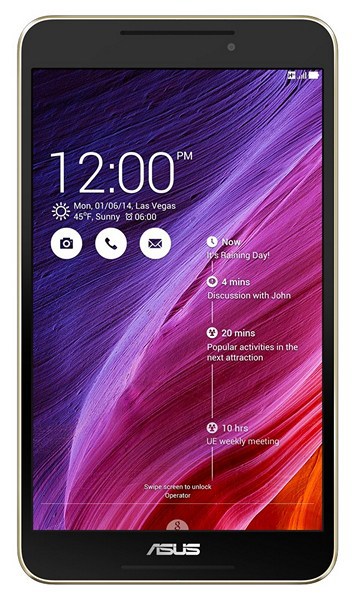
Mini-plates for a long time and firmly won a place in the sun. For many, they have become a kind of "gold standard", being much more compact, easier and more convenient for long-term use than full-size tablets. For the vast majority of tasks their screen size is enough for the eyes. And today I want to share with you a review of a very nice representative of the cohort of these small but functional gadgets - ASUS Fonepad 8.
I want to clarify right away: there are two Fonepad 8 models on sale - the FE380CG and the FE380CXG. The second model of the camera has a lower resolution (0.3 + 2 Mp), a weaker processor, and 8 GB of memory. The older model (FE380CG) - 16 GB. There was a CG on the test, but it was in this instance that the amount of memory was 8 GB. Although on sale, again, will be 16 GB.
Specifications (underlined those that correspond to the considered sample):
')
Operating system : AndroidTM 4.4.2
Display :
- 8 "LED Backlight WXGA (1280x800), IPS
- Support up to 10 simultaneous touches
- Oleophobic coating
Processor : Intel® Atom ™ Z3530 Quad-Core, 1.33 GHz, 64 bit
RAM : 1 GB / 2 GB
Data Store :
- 8 GB / 16 GB
- 5 GB ASUS Webstorage (lifelong), with an additional 11 GB for the first year
Supported network standards :
- HSPA + UL: 5.76 Mbps, DL: 42 Mbps
- 3G: WCDMA: 850/900/1900/2100
- 2G: EDGE / GSM: 850/900/1800/1900
Wireless data transfer :
- WLAN802.11 b / g / n
- Bluetooth V4.0
- Miracast
Cameras :
- 2 megapixel front camera
- 5 megapixel main camera with autofocus (video recording at 720p)
Sound : Stereo speakers with support for SonicMaster technology
Connectors :
- Micro usb
- 2-in-1 audio
- Micro SD up to 64 GB
- Two slots for microSIM cards
Sensors :
- Accelerometer
- Light sensor
- Compass
- Proximity sensor
- Hall Sensor
Battery : 15.2 Wh, Li-Po
Navigation : GPS, AGPS, GLONASS
Color : Gray-blue, white, red, golden
Dimensions : 120 x 214 x 8.9 mm (Width x Height x Thickness)
Weight : 310 gr
Information from the benchmark AnTuTu: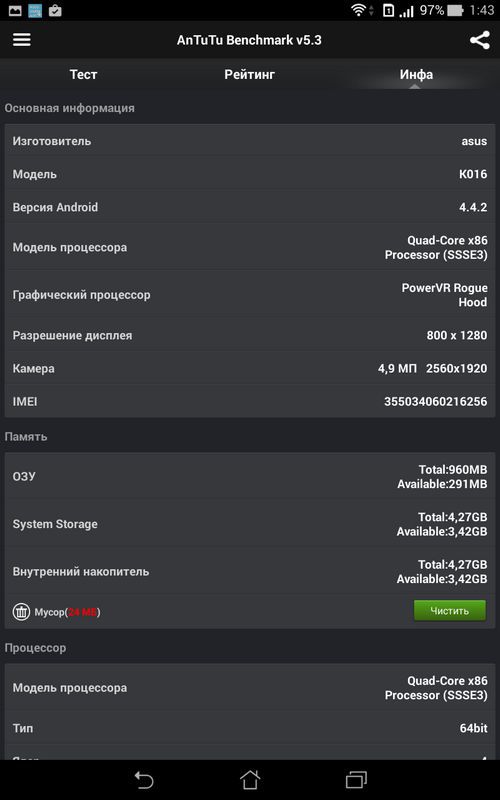







Appearance and equipment
There is almost nothing to say about the bundling: only a USB-microUSB cable and a compact charger (5.2 V, 1.35 A) are supplied with the tablet.
For this review, I got a model of a real male color version - dark gray-blue. Build quality traditionally for ASUS is very good, no backlash, no creaks, no bends.
The front side looks traditional, somewhat “refreshing” its thin silver edging around the perimeter of the device. By default, vertical orientation is assumed, and based on this, the front camera is located in the upper right corner. The frame on the sides of the display is quite narrow, so the overall dimensions of the device are very close to 7-inch tablets, although in this case the screen is much larger. Above and below the display are the slots of the speakers, which hints at the horizontal orientation of the device in order to experience the stereo effect.
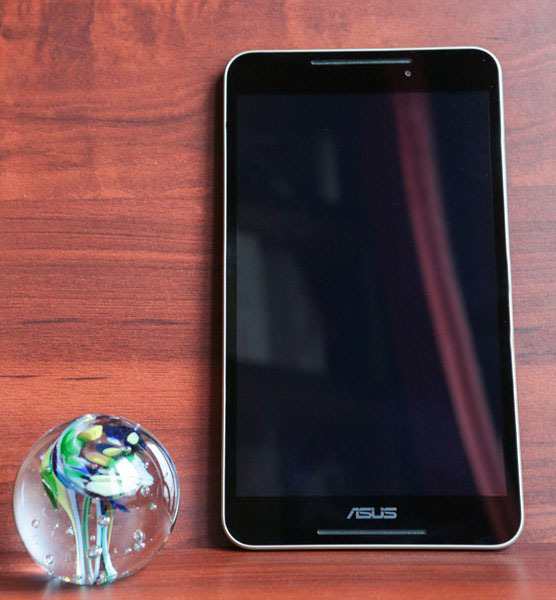
The reverse side is made in the form of a single panel of rough textured plastic gray-blue. The tablet lies in the palm of your hand securely, does not try to slip out, you can safely hold it with one hand.

In the upper left corner, if you look at the tablet from the back, the main camera, volume control rocker, power button, audio jack and microUSB jack are arranged.


At the bottom there is nothing, except for the tiny hole of the microphone. But on the right side there is a large swivel cap, under which there are two slots for microSIM-cards and a card reader for microSD.
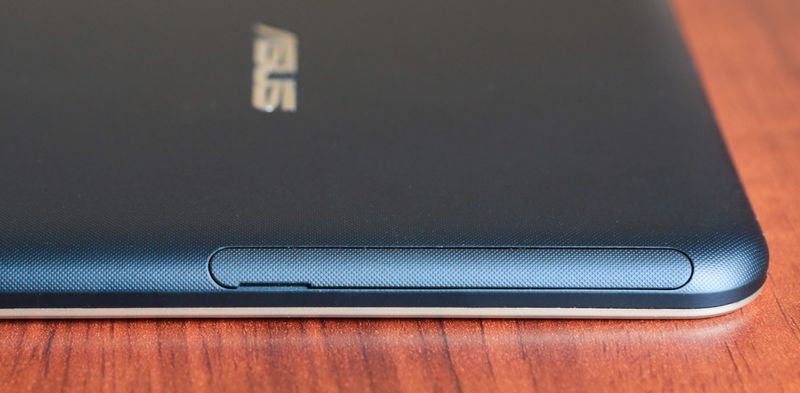

Display
The display resolution of ASUS Fonepad 8 is 1280x800, with a density of 213 dpi. Not so much in modern times, but it does not cause any discomfort.
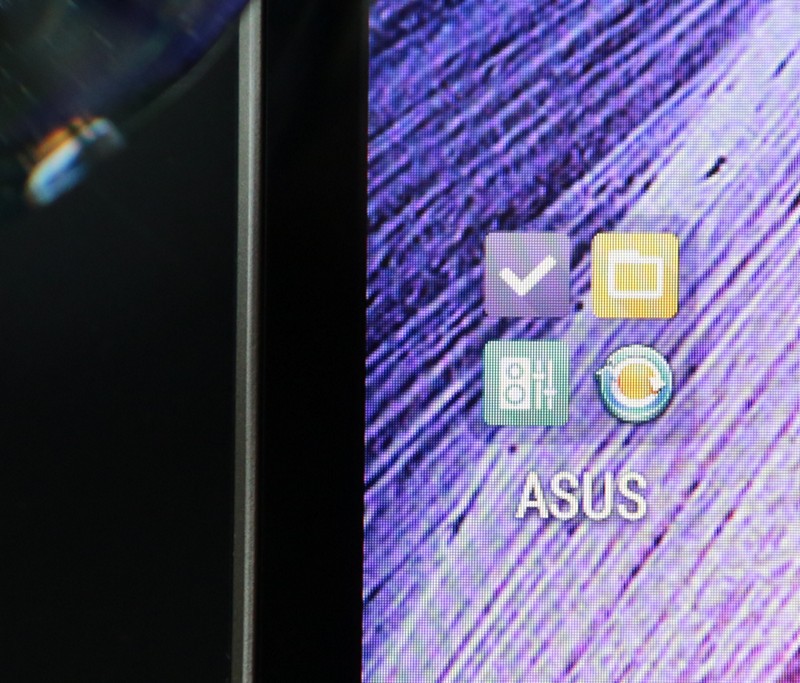
IPS-matrix provides a very decent color reproduction, contrast and wide viewing angles. The brightness is high, up to 400 cd / m2, you can easily use the tablet in bright sunshine. Alas, the display is covered with glossy glass with all the ensuing consequences. Of course, the oleophobic coating helps to reduce the intensity of the appearance of fingerprints, but it will not work to completely get rid of them.

Cameras
The front 2 Mp camera is traditionally suitable only for selfies and video calls. The main camera has a 5 megapixel matrix, is equipped with autofocus and can shoot video with a resolution up to 1080p. There is also a stabilization function to compensate for the tremor of the hands.
In general, the quality of both the photo and video can be called satisfactory, you should not expect much from this camera. On the other hand, if you need high quality photography, then it is better to get a full-fledged camera, for a tablet the camera is just a nice bonus.
Sound
The sound is quite high quality and balanced. It cannot be said that it somehow stands out for the worse or for the better, the sound is sound, the music, games and films sound very good. Although this, of course, not an audiophile device.
Software
Fonepad 8 runs on Android 4.4.2. Here is applied the new proprietary shell ASUS Zen in the trendy Metro-style, which is characterized by clean lines and simple graphic images.
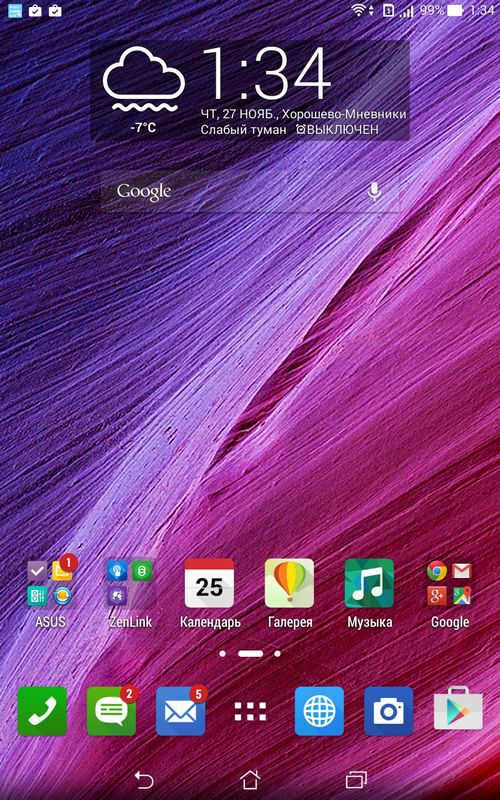

The top drop-down panel consists of two parts: if you drag in the upper right part of the screen, the following list of quick settings icons will appear:
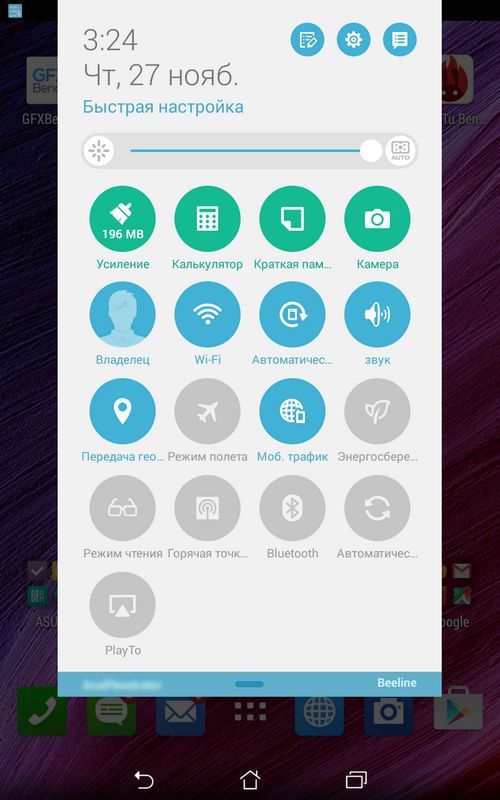
When pulling in the left and middle parts, the menu with a list of events and notifications falls out:
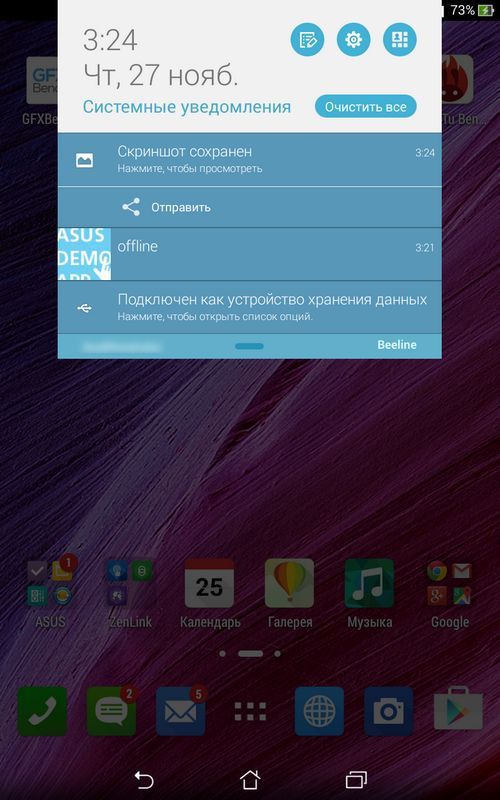
From the proprietary applications on the tablet are preinstalled:
Remote Link - allows you to use the gadget as a remote control.
Share Link - allows you to broadcast the image from the tablet to external devices.
Party Link - using this application, you can arrange a local wireless social micro-grid.
Splendid - program for fine tuning the color gamut of the display.
SuperNote is a note taking application that has already been mentioned in previous reviews.
Power management is a utility for setting power consumption modes.
Wireless and Navigation
The tablet can work in 2G and 3G networks, the LTE standard is not supported. Despite the presence of two slots for SIM-cards, they cannot work at the same time, since there is only one radio module in the tablet. So every time you have to choose programmatically which of the sims should be active, the second one at this time will work in standby mode. Not very convenient, but it is a traditional scheme, which is often used in dual-purpose devices.

Since the device is formally a huge phone, the proximity sensor turns off the display if you hold the Fonepad 8 to your ear like a normal smartphone. It’s hard to imagine who might think of a similar way to use this gadget, but still know that the manufacturer has taken care of this. When using the speakerphone, the sound quality is very good, the volume margin is more than enough.
The tablet finds navigation satellites quickly, as well as a connection is established. From the point of view of the average user there is nothing to complain about.
Performance
The heart of the tablet is a quad-core 64-bit Intel Atom Z3530 processor, clocked at 1.33 GHz. The amount of RAM in this model is 1 GB. To store data in the Fonepad 8 built-in 8 GB. This, of course, is not enough, but for such a case it is possible to install a microSD card with a capacity of up to 64 GB.
Impressions from the work of the tablet are somewhat dual. On the one hand, all applications and games work without problems, no brakes, hangs, etc. But at the same time, there is a certain slowness of reaction after pressing one of the system buttons (Back, Home screen, List of running applications). Some fraction of a second passes before the desired action is performed. Perhaps this is a feature of this test sample. Although, I repeat, in general, there are no complaints about the performance of the Fonepad 8: strategies, shooters and casual games, FullHD video (although it was meaningless in this case) worked without problems.
Benchmark results:
AnTuTu



Quadrant

Geekbench















Gfxbench

Vellamo





Speedtest (when connected via Wi-Fi)

Duration of work
The battery fully charges for about three hours. With an active load, - games, benchmarks, - the tablet worked for about 4 hours. In surfing mode with watching a couple of movies a day, the battery charge lasted about 9 hours with an average screen brightness. If you turn on the automatic adjustment of the backlight, you can increase the time for another hour and a half. According to ASUS, the tablet can work up to 21 hours in talk mode on 3G.
Conclusion
This is a pretty tablet with a large screen, not trying to compete with one and all. High-quality workhorse, without any over-the-top performance, but at the same time capable of satisfying virtually any needs of the average user. On the Fonepad 8, you can play with equal comfort and watch a movie (at 8 inches you don’t have to “break” your eyes) and surf. Of course, if you desperately need a higher resolution display, it is better to look at other models of tablets. But a higher resolution doesn’t have a better effect on the device’s operating time, so it’s better to think a few times whether you really don’t have enough pixels, or just want a better feature.
The rear plastic cover forgives even the very careless treatment of its owner. In my opinion, this tablet can be advised to students as an office device for issuing to employees in the corporate sector. These two categories of users will well have the way and the ability to install two SIM-cards, even the same students - to share personal life. Or use different operators, saving on the cost of services in different tariffs.
Recommended retail price: 8990 rubles for the FE380 CG and 7990 rubles for the FE380CXG.
Source: https://habr.com/ru/post/363673/
All Articles